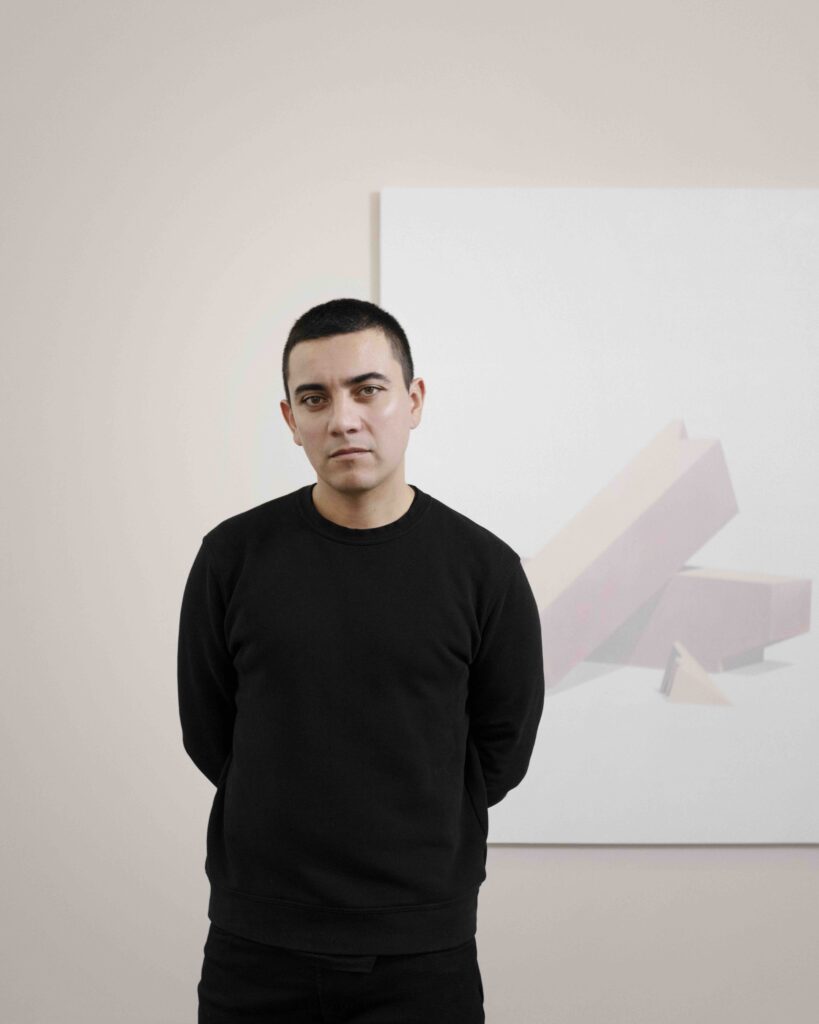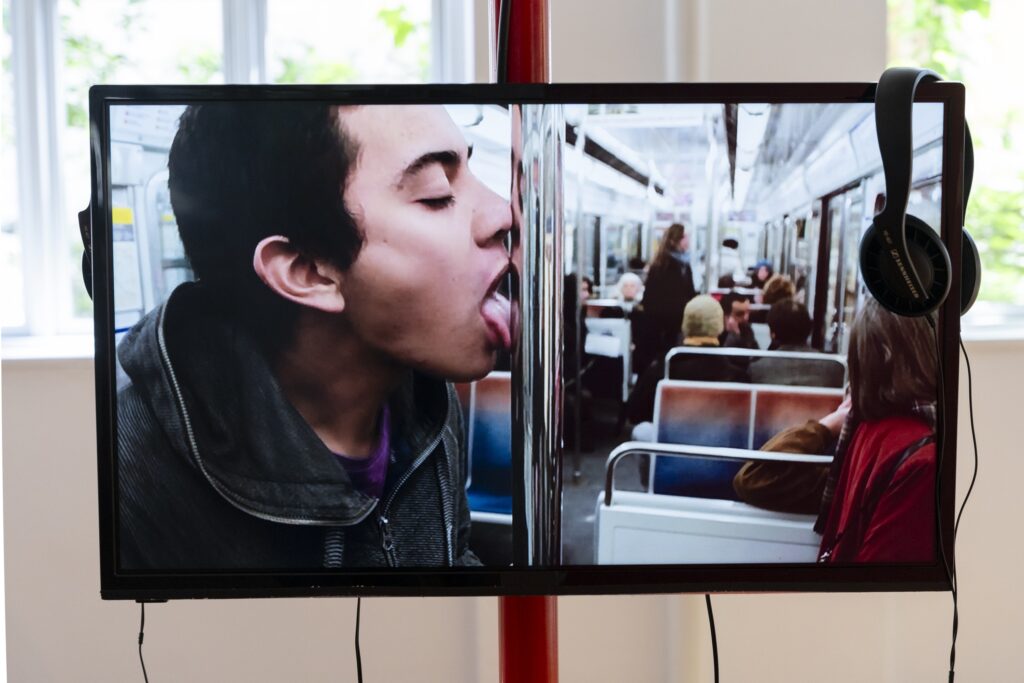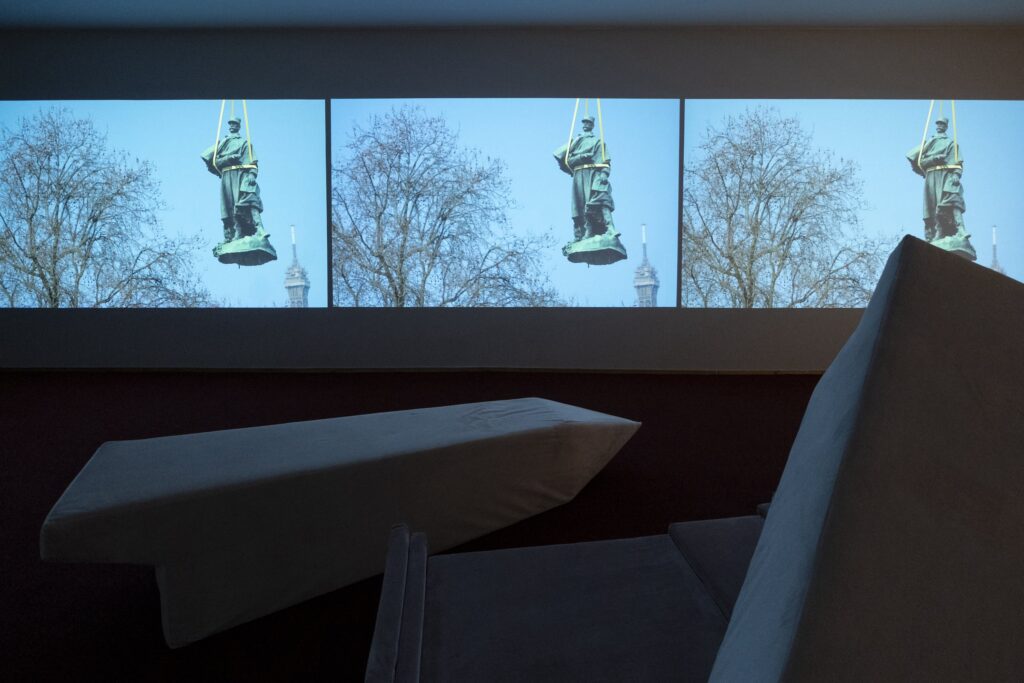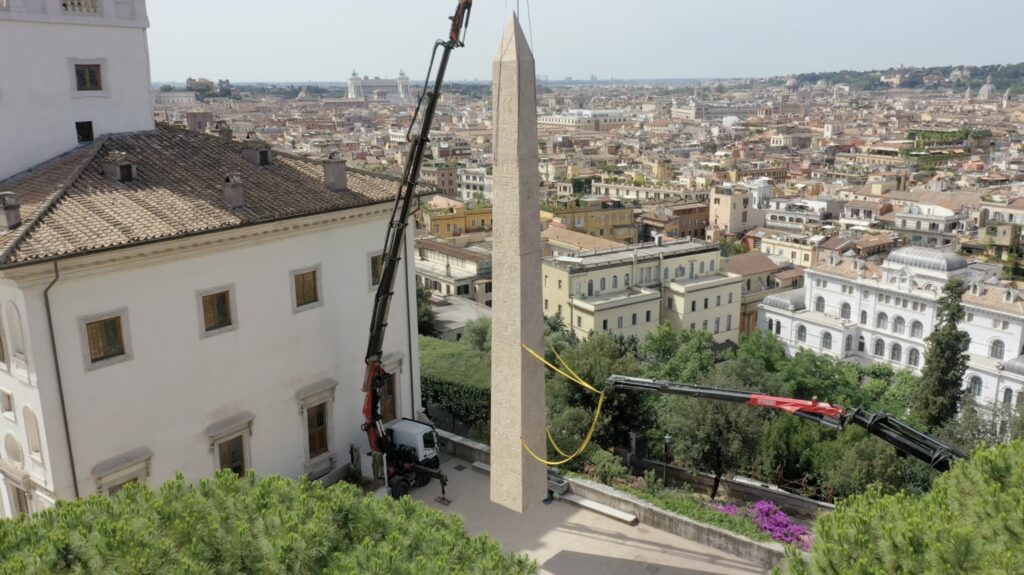Altruism (2011) is one of the first artworks that meets you when you enter TO MOVE AND BE MOVED, Colombian artist Iván Argote’s exhibition at KØS (Museum of Art in Public Spaces, Køge). It is a short video where Argote stands in a metro in Paris. He looks at the steel pole in the middle of the carriage and hesitates for a second, then starts kissing the pole like there was no tomorrow. Soon the other passengers start looking at him with disgust and they move away from him one by one. In an innocently offensive way, the work confronts us with how averse we are to each other and to the things we share as strangers in public space. Argote’s performative works have caught my attention in the ways they mix old traditions of situationism with newer movements of care and tenderness. TO MOVE AND BE MOVED, curated by Irene Campolmi, shows a broad spectrum of Argote’s practice that mixes video, sculpture, painting, and performance. From the first DIY projects in public space to his big scale interventions that criticize colonial monuments in cities around Europe. In the context of the exhibition at KØS, Argote’s first in Scandinavia, I visited his studio in Paris to talk about his approach to the performative aspects of his work, about intimacy, publicness, power, and rest.

Joachim Aagaard Friis [JF]: When I first got familiar with your practice, I was interested in how you work with the relations between the public and the private. How did you start exploring these polarities?
Iván Argote’s [IA]: I guess first by the influence of my family who were Marxist revolutionaries. When I grew up, we wouldn’t talk about TV-shows or soccer or anything like that, we would only talk about politics. I soon got interested in how the structures of society affect not only how we think, but also the truths that we are living on. Later, I started studying graphic design, but I also wanted to do philosophy. I was interested in how and why we think, thinking as an object. But I am a very bad reader! At the same time, I was questioning the object of knowledge as a pure entity, and this led me away from philosophy in the classic sense. I don’t think there is this straight division between the body, feelings, and knowledge. I think it is the same entity, the same flux of emotions and, like, electric connections that happen in the brain. This is still a mystery. But I guess these thoughts were what led me to a more artistic approach than my family had, while still using many of the same political ideas.
JF: Can you say more about how you were led to work artistically with issues of the public sphere?
IA: One of the first inspirations is this experience when you take a walk into the city, and you open yourself up to a more sensitive mode. You become aware of how many emotions that are present in this space. Every few meters you are reminded of different emotions, of history and of ideological influences. You have historical violence and capitalist violence at every turn, through monuments and advertisement. And I think this is so overwhelming that we have learned to numb ourselves to not pay attention to it, otherwise we would go crazy. But if you really take a step back and sensitize yourself to this panorama, it is a very noisy zone. I think many of the intentions of my works come from this experience, and from the effort to renegotiate that, to propose new ways to conceive of our interactions with others in public space, of the historicity of this space that we share and the ideas we cultivate through the architectures of power. My whole practice begins from these walks, of reading the city as a noisy complexity.
JF: Let us go back to when you first moved to Paris, and you began your art practice. I saw some of your early works which were related to this ‘reading’ of the city through a kind of situationist approach.
IA: I moved from Bogotá to Paris in 2006. I had never been outside of Colombia, I didn’t speak French nor English, but I ended up learning quite quickly. I remember the first months, it was so cold, the first winter in my life. There was no GPS back then, you only had printed maps, and in Paris the streets were twisted and confusing. Sometimes when I got lost, I got desperate and worried, and I wanted to cry. I thought ‘what do I do if something really bad happens? Nobody knows me here’. But at the same time, I felt a rush of happiness because of the freedom that this position gave me. No one knew me and I could invent a whole new Iván. I think this spirit was very present in the first performative works I made. I remember thinking: ‘I am alone but among 10 million people. So, I’m alone together’. In public space, it seems like there is a common decision to impose an unconcerned and distanced attitude to strangers. I tried to confront that in my works, maybe because I had this looser sense of who I was. In these performances, I also played with the theme of my own loneliness. For example, I would do a performance in a bus, where I acted as if I was on a trip with my family (We are all in the bus, 2009). So, while filming, I named the other passengers on the bus my mom, my uncle, siblings etc.
JF: I remember that you didn’t get such a positive response in that one.
IA: No, but I think it was also a way to respond to that silent violence you get when you are a migrant. So, this was my artistic response to that experience, to confront the rest of the world – me against Paris. But instead of a traditional aggressive confrontation, I was like: ‘I am going to propose you to kiss me’ or ‘I am going to try to be nice to you and see how this affects you’. So, there was a lot of that.

JF: I thought about the confrontational aspect, because even though you see your practice as a way of connecting to people in public space, it can also feel violent for some to be recorded without warning.
IA: Yes, but the camera also acted as my own protection, between me and the world of this big city. I like that video in the bus, it is only 40 seconds long, but it shows a lot of emotions. The passengers are so spaced out when I start performing. Later it seems they are thinking ‘either this guy is on drugs, or he wants to sell me something’. I know that being recorded can be disturbing, but I am nice the whole time, smiling and trying to connect. I also did several other performances, and some I didn’t even film. I built up an archive and a practice gradually. For example, I did many performances with singing leading up to the one I recorded where strangers sing a birthday song for me in the elevator (Birthday, 2009). I asked myself, how can I ‘perform’ people in public space into a common kind of collectivity. I bought a kid’s recorder and a mic, and then I just walked around in the metro and asked people to sing together with me.
JF: How were the reactions in general? What I got from your videos were mostly either indifferent, nervous or quirky looks.
IA: You have all that, but also positive and engaging ones. You have people who understand my intentions and who get to the next layer of the performance, not just responding to the invitation but also to the concept. You can recognize very easily the complicity of a look. This also happened the times when I was giving out money in the metro – or I tried, but very few accepted the money. After a couple of years however, people began to question me a lot, asking what my agenda was. I got tired of that, and I didn’t want to be known only as the guy who did these performances. So, around 2012 I stopped filming myself and began doing some museum shows with those videos from the past.
JF: What happened from then on?
IA: I went more back to my family roots. In the video La Estrategia from 2012, I reenact the militant community that my parents were part of as revolutionaries in Colombia in the 1970ies. I invited a group of people and made a documentary of how they lived. You basically follow this revolutionary group, but as a reenactment, almost a reality show. There were a lot of rules in these communities like you couldn’t dance because it was too bourgeois, you had to wake up at five AM every day and run, read a lot of Marx and Engels, train with guns and so on. I wanted to explore all that. And in fact, my family’s knowledge would be relevant many times in my projects. For example, when I did the series of performances where we pretend to remove sculptures in public space (Au revoir Gallieni, 2021, Levitate, 2022, Paseo, 2022), my father advised me to get permission from the city hall to film on these squares. This meant that if the police came and asked me what I was doing with the sculptures, I could just refer to the permission that was given to film.

JF: So, in a sense, the permission to film allowed you to treat your actions on the square as if they were fiction?
IA: Yes, the camera became sort of a protection for us to do a political action. Sometimes I was covering the monument and making it disappear for a while, but by referring to it as something to be filmed, the police would not interfere.
JF: I know that you already did a performance where you ‘drowned’ a bust back in 2009 in Bogotá (Glup Glup (Monument)). But what led you to these big scale performances in public space that are so far from the DIY projects that you started out doing?
IA: Actually, I have been doing this type of critical sculpture intervention several times, and they just kind of grew in scale, with more or less risk and surveillance. For example, in L.A., I think it was in 2014, I did a performance with a sculpture of the founder of the city (Turistas, 2012-present). It is placed in the historical center of L.A. that has become a kitschy place with vendors selling all kinds of Mexican stuff. I bought a poncho from one of these stores and put it on the sculpture. This became the beginning of a series of interventions where I dress the sculptures as an act of care but also to disrupt their power.
JF: And then more recently, with your works in Paris, Rome and Madrid, you used fake news which seems like a new dimension of your practice. How did that evolve?
IA: It started in Paris where Françoise Vergès, a decolonial and feminist thinker, approached me and was like, ‘I saw your interventions with the ponchos, let’s do something similar here in Paris’. We began thinking about Joseph Gallieni (a French military officer in the second half of the 19th century red.) and how he is represented in public space in Paris. Everyone here knows Gallieni by name but not many knows what he actually did. His history is very violent and the monument of him in Paris (at Place Vauban, from 1926 red.) is horrible. It shows him standing on four women who are holding him up, they are all non-white and half naked. It looks very humiliating. When really looking at this, I was thinking, you can’t do anything other than remove this thing. Therefore, we wanted to start a conversation, and this required a bigger project. It turns out that France is much more behind on this than say the U.S., but at least we wanted to accelerate the conversation a bit. So, we enacted a fake takedown of the Gallieni sculpture. We hired workers, a crane, some actors pretending to be officials and so on. We filmed the whole sequence up to the point where the sculpture was removed which we made digitally. A media outlet accepted our proposition to make a fake news story, and for a short time, this event generated a lot of discussions on both sides of the divide.

JF: Recently you have also done another type of installation where these monuments are cut into pieces and put on the ground. Can you tell a bit about this move?
IA: The video I did with Gallieni was like a science fiction film, but from the present. It is what I call ‘next week science fiction’. Since reality is so surreal already, why couldn’t these monuments be demolished in a week? This current project (Descanso, 2024, currently at the Venice Biennial red.) is an image of what could happen 100 years from now – when the monuments are already buried. There is a soft aggression in the gesture of just taking the monument down – not demolish or destroy it – just putting it to rest on the ground. And letting us, the public, take a rest from these monuments as well. And then I used all these ‘migrant plants’ that are labeled as invasive and come from outside of Europe to grow around sculpture. To underline a kind of sweet revenge of the migrant. The sculpture in this work is of Christopher Columbus. I didn’t have the opportunity to go back to Venice since the opening, but I heard that the plants have completely overgrown it now. When I was first invited by the curator Adriano Pedrosa, he wanted to make an area in Giardini with ‘pavilions’ for countries that never had one before, and Colombia is one of those countries. In the end he didn’t want to name them pavilions since that would reiterate the problematic concept of nationalism. But I liked the idea of pavilions without walls that were treated as independent territories. I wanted to treat the space as an architecture that was but is no more. Also, Colombia literally means the land of Columbus, even though he never even set foot there. For me it was good to deliver him back to Italy where he is from. To say: ‘here, take him back, we don’t need you anymore’. It was important to create an artwork that tries to put all that violence to rest.
TO MOVE AND BE MOVED by Iván Argote is on show at KØS – museum of art in public spaces until November 17.
More from Joachim Aagaard Friis
